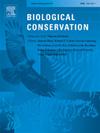Habitat preference contributes to explaining the varied sensitivity of bats to anthropogenic noise
IF 4.9
1区 环境科学与生态学
Q1 BIODIVERSITY CONSERVATION
引用次数: 0
Abstract
Anthropogenic noise is a global pollutant that negatively affects a wide range of wildlife, both on land and in water. It has long been recognized that there are marked variations in animals' sensitivity to noise disturbance across individuals and species and behavioral contexts for the same individuals. For biodiversity conservation and management, it is important to understand the underlying mechanisms for the subject- and context-dependent responses of wildlife to human disturbances. Here we used meta-analysis and statistical models to understand the biological and ecological traits that may explain the differential responses of bats to anthropogenic noise. Bats, the second-largest order of mammals, play indispensable ecological roles but face various human threats. The literature survey revealed that only 33 studies had investigated the effects of anthropogenic noise on 60 bat species, representing approximately 4 % of the total bat species and being largely (92 %) restrained to the families Vespertilionidae and Molossidae. The statistical analyses revealed that transportation and urban noise were the more disturbing to bats. Bat species that forage in narrow and edge spaces were more sensitive to anthropogenic noise than those that forage in open spaces. Bat species using longer echolocation calls were more sensitive to noise disturbance. Furthermore, compared to orienting and vocalizing bats, foraging bats were more sensitive to noise disturbance. These data indicated that anthropogenic noise, particularly traffic noise, needs to be carefully managed for forests and other types of vegetation used by foraging bats.
求助全文
约1分钟内获得全文
求助全文
来源期刊

Biological Conservation
环境科学-环境科学
CiteScore
10.20
自引率
3.40%
发文量
295
审稿时长
61 days
期刊介绍:
Biological Conservation is an international leading journal in the discipline of conservation biology. The journal publishes articles spanning a diverse range of fields that contribute to the biological, sociological, and economic dimensions of conservation and natural resource management. The primary aim of Biological Conservation is the publication of high-quality papers that advance the science and practice of conservation, or which demonstrate the application of conservation principles for natural resource management and policy. Therefore it will be of interest to a broad international readership.
 求助内容:
求助内容: 应助结果提醒方式:
应助结果提醒方式:


